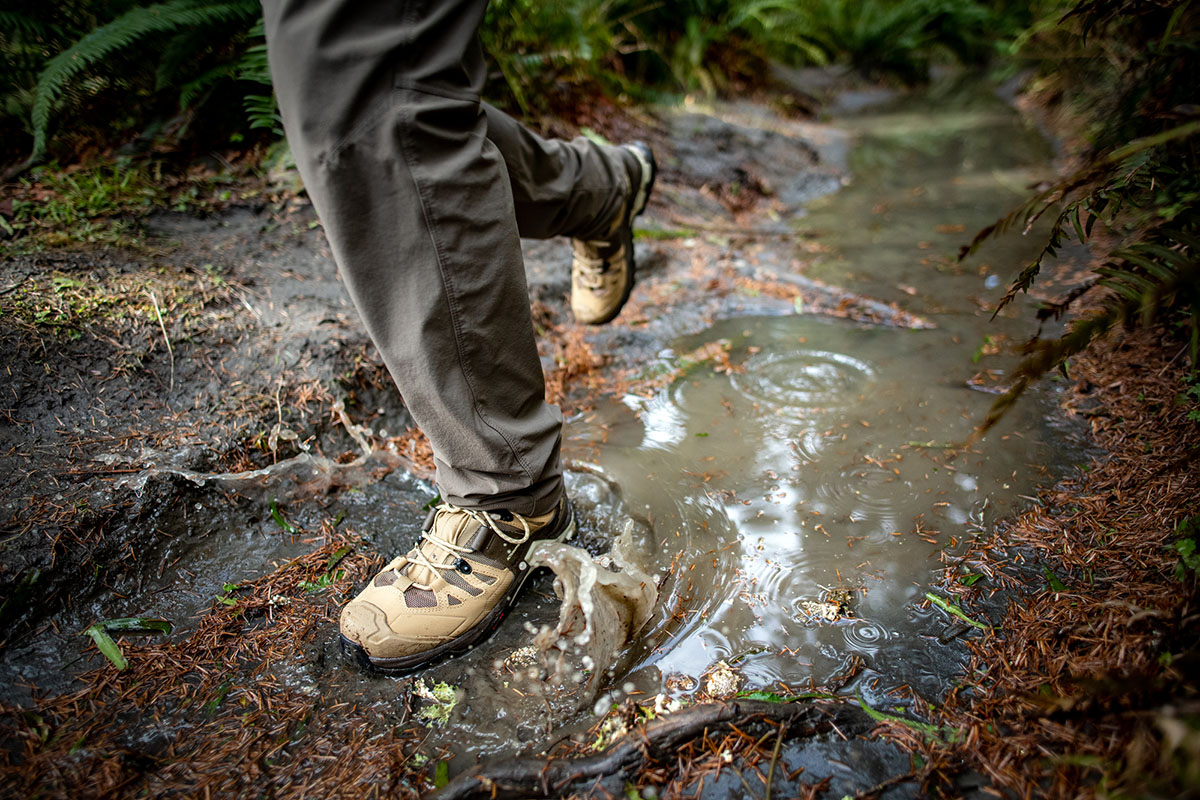
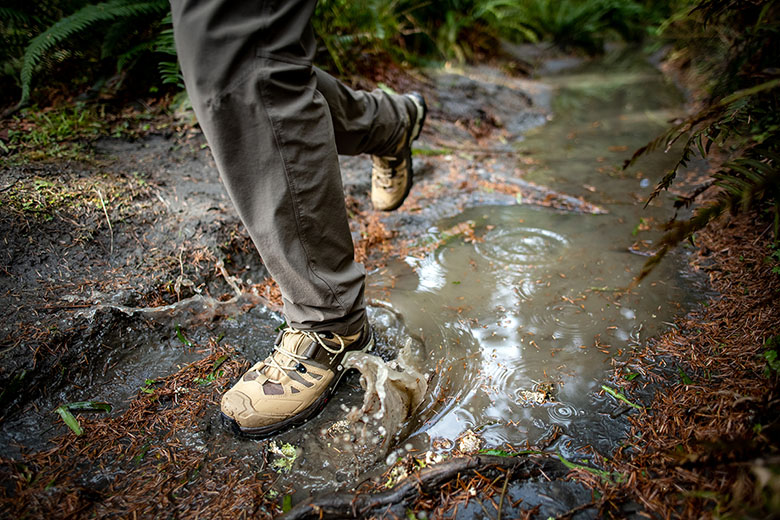
Salomon is a clear frontrunner in the hiking footwear market, with an extensive collection that ranges from capable backpacking-ready boots to light and nimble low-top shoes. At the time of publishing, their hiking lineup comprises 14 core models—many of which are offered in multiple styles and variations—so there’s a lot to consider. To help you better navigate Salomon’s offerings, we’ve broken down each product below to highlight where it excels (or doesn’t), what type of terrain and hiker it’s best for, and how it compares to other Salomon models. For more information, see our comparison table and buying advice below the write-ups. And for a wider look at the market, see our articles on the best hiking boots and best hiking shoes.
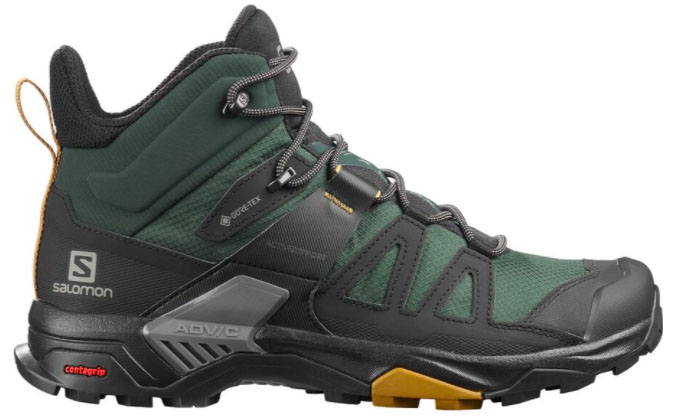 Weight: 1 lb. 14 oz.
Weight: 1 lb. 14 oz.
Waterproof: Yes (Gore-Tex)
What we like: Standout mix of weight, comfort, and on-trail performance.
What we don’t: Relatively thin underfoot and lower ankle height than Salomon’s Quest.
The X Ultra is Salomon’s flagship hiker and has gained remarkable popularity over the years for its combination of weight, price, and long-distance comfort. Recently updated to the “4,” the latest version carries the torch: The mid-height boot is nimble, light at under 2 pounds, and flexible while still fully capable of shuttling a light pack on multi-day backpacking trips. Build quality and traction are top-notch as well, with hardwearing materials that have stood up impressively well to testing and a trustworthy Contagrip outsole that does a great job biting into everything from deep mud to slippery roots and logs. At $165, Salomon managed to pack in a ton of performance at a very reasonable price point.
All that said, for carrying a heavy pack over technical terrain, the X Ultra falls short of Salomon’s Quest below in a few key areas. Most notably, the fairly thin padding underfoot can lead to foot soreness when covering longer distances over hard and rough surfaces (the older X Ultra 3 has a bit more cushioning), and the collar sits fairly low for a backpacking boot and can let in trail debris and water more readily. The Quest is also the stiffer design, which translates to increased stability and support when navigating tricky trails. But for backpackers and hikers who travel light or stick to maintained paths, the X Ultra 4 Mid puts it all together better than most. And for those who still prefer the cushioning and fit of the X Ultra 3, it’s still widely available (and outlined below). Importantly, the X Ultra line also includes the low-top variation below, as well as the leather X Ultra Trek... Read in-depth review
See the Men's Salomon X Ultra 4 Mid GTX See the Women's X Ultra 4 Mid GTX
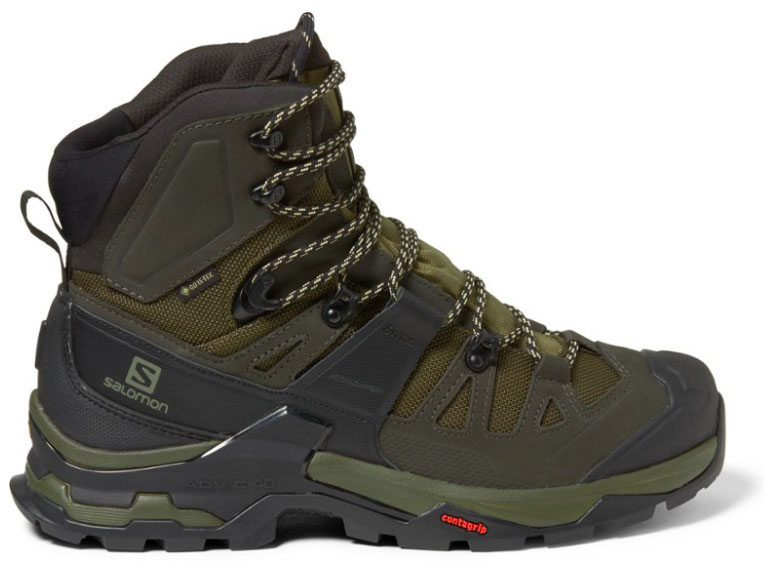 Weight: 2 lbs. 14.2 oz.
Weight: 2 lbs. 14.2 oz.
Waterproof: Yes (Gore-Tex)
What we like: Tough, protective, and supportive for shuttling a pack over technical terrain.
What we don’t: Fairly heavy and overkill on smooth and maintained trails.
As we touched on above, Salomon’s Quest is a step up from the X Ultra in stiffness, coverage, and overall protection but still plenty comfortable over long distances. This combination makes it a great match for backpacking trips that involve navigating rough and rugged terrain, where the added support and cushion do an excellent job taking the sting out of harsh impacts. We’re also big fans of the Quest’s confidence-inspiring lacing system, which makes it easy to get a secure fit and keeps the heel snugly in place even on steep and extended climbs. Finally, as with the X Ultra, the Quest is well built and very grippy over most surfaces.
Backpackers embarking on multi-day trips with a heavy load will likely find little to complain about with the Quest, but it’s decidedly overbuilt for traveling fast and light on easier terrain. For this, we would turn to the aforementioned X Ultra for its much lower weight (by just over a pound) and sprightlier feel. Alternatively, Salomon sells a lighter variation called the Quest Element, although you do make some small concessions in support. All in all, the standard Quest truly is a winner from a performance perspective, and the added heft is a reasonable tradeoff for those who need the bump in protection and stability... Read in-depth review
See the Men's Salomon Quest 4 GTX See the Women's Salomon Quest 4 GTX
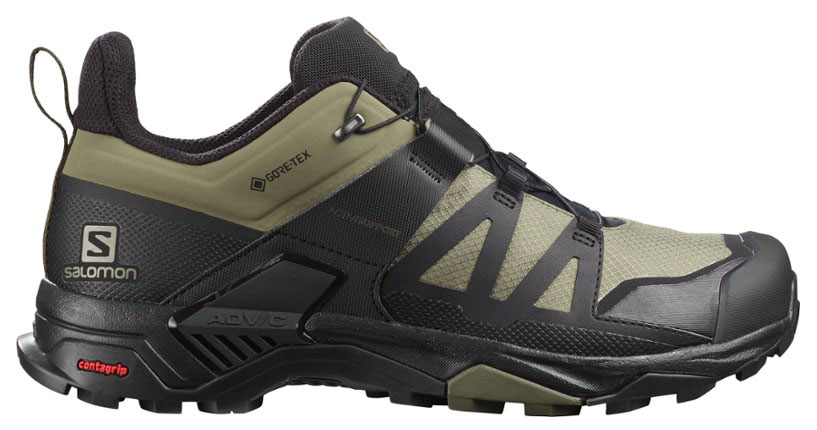 Weight: 1 lb. 11.5 oz.
Weight: 1 lb. 11.5 oz.
Waterproof: Yes (non-GTX available)
What we like: Similar all-around performance to the X Ultra Mid in a lighter, low-top design.
What we don’t: Raised collar can lead to ankle rubbing and discomfort.
For those who don’t want or need the added ankle coverage of the X Ultra 4 Mid above, the low-top variation is similarly competitive. Overall performance is very comparable between the two models, including an excellent balance of support and flexibility, high-quality and durable materials, and enough cushioning for day hiking and light backpacking. At 1 pound 11.5 ounces, the X Ultra 4 GTX is a little heavier than some of Salomon’s other hiking shoes, including the 1-pound-8.6-ounce OUTline below, but it’s far and away the more capable design. And like the Mid, the X Ultra 4 GTX shoe got a recent revamp, with notable changes including a modernized look, revised Quicklace system and chassis, and higher-volume fit in the toe box.
However, Salomon also raised the collar around the front of the ankle, which some users have reported to be a source of rubbing and discomfort. We didn’t experience this issue ourselves when testing the shoe, but it’s best to try it on before you buy, even if your feet have fit well in prior versions. This complaint aside, the X Ultra 4 remains one of the most competitive and well-rounded hiking shoes on the market, and it’s also offered in a non-waterproof variation for a boost in breathability and slight drop in weight and cost. And for $15 less, the X Ultra Pioneer model is a slightly less technical version that retains most of the stability, grip, and support of the X Ultra series (although it uses proprietary waterproofing tech and standard laces)... Read in-depth review
See the Men's Salomon X Ultra 4 GTX See the Women's Salomon X Ultra 4 GTX
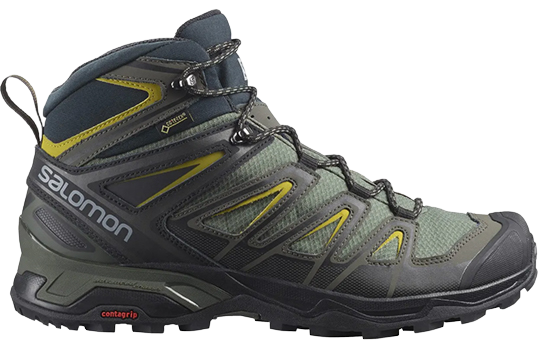 Weight: 1 lb. 15.7 oz.
Weight: 1 lb. 15.7 oz.
Waterproof: Yes (Gore-Tex)
What we like: Better padding and coverage than the newer X Ultra 4.
What we don’t: Design is a little dated; we'd opt for the Quest for more technical terrain or heavy loads.
The predecessor to Salomon’s X Ultra 4 Mid GTX above, the X Ultra 3 Mid GTX is still widely available in many sizes and multiple colorways—and some prefer it for its fit and increased cushioning. Like the X Ultra 4, the X Ultra 3’s lightweight build nicely balances comfort, durability, and rock-solid traction but with a little more padding underfoot for taking the sting out of harsh impacts. It also rides a little higher around the ankle and lacks the 4's weight-saving cutout along the back of the collar. Overall, both versions manage to blend impressive durability and comfort into a lightweight package, though the X Ultra 4 is a bit more streamlined.
A final decision between the X Ultra 3 and 4 will likely come down to preferences on weight and fit. The newer version shaves off around 2 ounces per pair but sacrifices some cushioning and comfort. As we mentioned above, the 4’s collar also sits fairly low and is more prone to letting in trail debris and water, and it’s slightly wider than the prior generation (although both are still on the narrow side of average). And a final—albeit entirely subjective—difference is styling: While the X Ultra 3 has been around a while, the 4 has a decidedly modern look and feel. But there’s a reason we've kept the X Ultra 3 at the top of our hiking boot round-up: It still holds its own in the market... Read in-depth review
See the Men’s X Ultra 3 Mid GTX See the Women’s X Ultra 3 Mid GTX
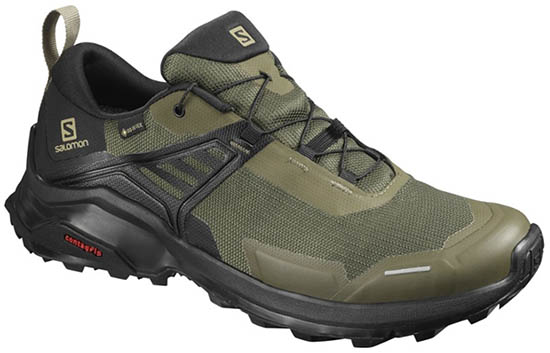 Weight: 1 lb. 7.6 oz.
Weight: 1 lb. 7.6 oz.
Waterproof: Yes (non-GTX available)
What we like: Plush but supportive cushioning provides excellent comfort over long distances.
What we don’t: Disappointing traction in wet conditions.
Light and flexible hikers often sacrifice some performance to shave weight, but Salomon’s X Raise Low GTX doesn’t succumb to the normal pitfalls. At 1 pound 7.6 ounces, it’s around 4 ounces lighter per pair than the X Ultra 4 above but still plenty capable for most easy to moderate backpacking trips. Comfort in particular is excellent, with a generously padded collar and underfoot cushioning that nicely balance plushness and protection for long days on the trail. Added up, the X Raise is truly a standout among fast-and-light designs, including the similarly intentioned OUTline below.
Salomon’s X Raise is in many ways a beefed-up running shoe, with added durability and support for shuttling a pack over long distances. However, stacked up against the X Ultra 4 above, the X Raise is less confidence-inspiring for navigating more technical trails, and it’s not as protective or grippy. We found traction to be especially disappointing while hiking over wet rock, where the shoe was surprisingly slippery and hard to trust. Salomon does offer a mid-height version with a bit more ankle protection and added stability from their Advanced Chassis for $20 and 3.6 ounces more, but the outsole issues remain. Given these experiences, we think the X Ultra 4 balances its priorities a bit better, but the X Raise is a nice alternative for hikers who put a premium on comfort and want a flexible, trail runner-like feel... Read in-depth review
See the Men's Salomon X Raise Low See the Women's Salomon X Raise Low
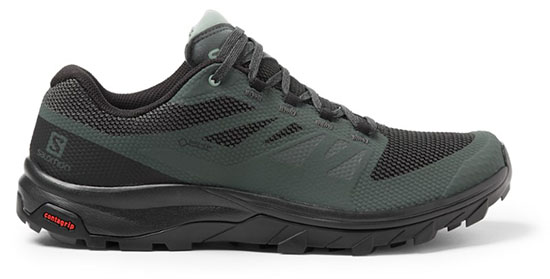 Weight: 1 lb. 8.6 oz.
Weight: 1 lb. 8.6 oz.
Waterproof: Yes (non-GTX available)
What we like: The feel of a running shoe with the sole and traction of a hiker.
What we don’t: Limited cushioning and support.
The OUTline is another one of Salomon’s running-inspired designs, with a light and decidedly modern build that wears well around town (not something we say often about hiking shoes). Traction is also well suited for trail use, with relatively deep and generously spaced lugs that gripped well on everything from rocks to light mud. And compared to the shoes above, the OUTline is the sleekest and most urban-friendly design of the bunch. Available in options ranging from a non-waterproof shoe to a mid-height Gore-Tex boot, all OUTline models offer a nice combination of flexibility and bite.
Despite their similar pricing and weight, the OUTline and X Raise above have very different personalities: While the X Raise is noticeably plush and well cushioned for long-distance comfort, the OUTline has very minimal padding, and both of our testers experienced foot soreness during long day hikes. On the same outing, the toe cap also began peeling back after just 13 miles on the trail, which makes us think Salomon went a little too far in shaving weight. To be sure, the OUTline is a fine option for short outings on established paths, but it lacks the comfort and durability for anything more serious. For more ambitious trips into the backcountry, we would instead stick with the X Raise or X Ultra 4... Read in-depth review
See the Men's Salomon OUTline Low See the Women's Salomon OUTline Low
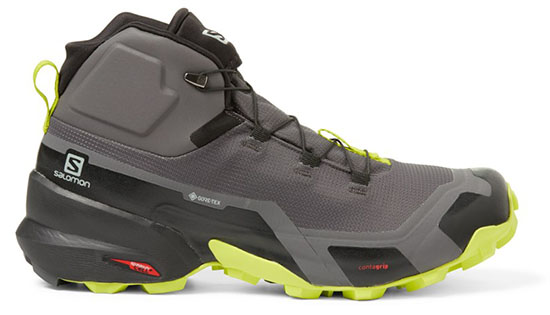 Weight: 1 lb. 11.9 oz.
Weight: 1 lb. 11.9 oz.
Waterproof: Yes (Gore-Tex)
What we like: Despite the mid-height cut, the Cross Hike is very agile on the trail.
What we don’t: Lacking in support and durability.
Salomon’s Cross Hike Mid slots in as another agile and sprightly design but with ankle-height coverage and protection. Like the X Raise and OUTline above, the Cross Hike clearly showcases Salomon’s trail running roots, with a nimble personality and low weight (1 lb. 11.9 oz.) that undercuts the X Ultra 4 Mid GTX above by around 2 ounces per pair. Another standout feature is the contemporary design and styling, which includes Salomon’s single-pull Quicklace system for quickly and easily cinching things down on the trail. Comfort and traction are good as well, with a nicely cushioned interior and deep, multi-directional lugs that perform well in mud and dirt. Unlike most other designs here, the lugs also extend over the front of the boot for maintaining contact on steep slopes.
However, in testing the Cross Hike, we found it to be less well rounded than the X Ultra 4. In particular, the lacing system is overly simplified and doesn’t extend high enough on the collar, which causes the boot to gape open and allow trail debris in at the top. We also experienced premature delamination issues, including the upper separating after just a couple outings. Additionally, similar to the X Raise above, the Cross Hike’s traction suffered over wet rock, and it’s noticeably less stable than most traditional hiking boots. In the end, the Cross Hike is a step up in overall performance from the OUTline Mid and a better match for longer day hikes, but we’d go with the $5-cheaper and barely heavier X Ultra 4 for more demanding hiking and backpacking... Read in-depth review
See the Men's Salomon Cross Hike Mid See the Women's Salomon Cross Hike Mid
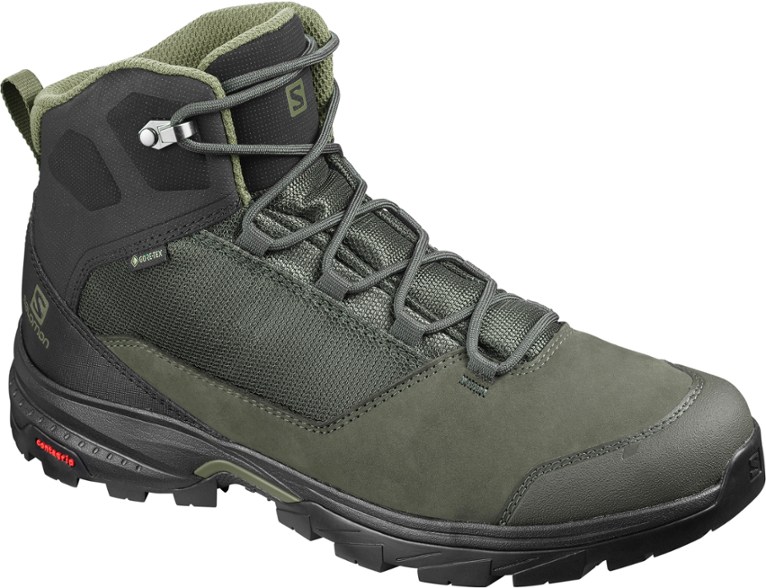 Weight: 1 lb. 15.7 oz.
Weight: 1 lb. 15.7 oz.
Waterproof: Yes (Gore-Tex)
What we like: Cheaper than the X Ultra 4 and includes quality and durable nubuck leather.
What we don’t: Falls short of the X Ultra in comfort, stability, and traction.
Coming in just under the X Ultra 4 in price and performance is Salomon’s Outward Mid GTX. The biggest news with the Outward is its quality nubuck leather and mesh upper, which has proven to be impressively hardwearing and long-lasting throughout testing. Weight is also competitive at under 2 pounds, which gives the Outward a responsive feel (not common among leather hikers). At $150, the Outward adds up to a solid value considering the high-quality materials and decent all-around trail chops, and it’s stylish and good-looking to boot.
All that said, for $15 more, we still prefer the X Ultra. The Outward is noticeably less plush and cushioned underfoot, which translates to reduced long-distance comfort. The minimalist interior also led to issues like a pressure point under the tongue and hot spots and rubbing at the heel, which were especially bothersome on extended climbs. In terms of support and stability, the Outward has a narrow heel that made it feel a bit less planted on the trail than the X Ultra, and traction is a slight step down as well. And a final downside is the lack of variety: The Outward is only offered in a waterproof, mid-height version, which is limited compared to the rest of Salomon’s lineup... Read in-depth review
See the Men's Salomon Outward Mid See the Women's Salomon Outward Mid
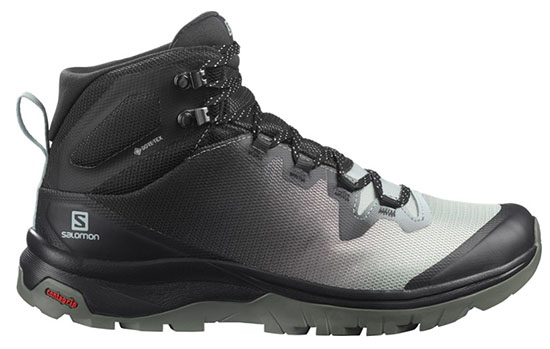 Weight: 1 lb. 7.3 oz.
Weight: 1 lb. 7.3 oz.
Waterproof: Yes (non-GTX available)
What we like: Light weight and quality build at a reasonable price.
What we don’t: Less stable and confidence-inspiring than the X Ultra 4.
The Vaya is Salomon’s women’s-specific collection, ranging from a lightweight, non-waterproof model to an insulated, faux fur-equipped winter version called the Vaya Blaze Thinsulate. The Mid GTX model listed here is our favorite of the bunch, combining a light weight with quality materials at a reasonable price point. The SensiFlex synthetic upper is designed to stretch to accommodate natural foot swelling, while the soft and nicely padded collar gives it a foot-hugging feel. The Vaya won’t be confused for a rugged trail-worthy backpacking design like the Quest or Quest Element, but it’s reasonably supportive and protective enough for easy to moderate trips.
How does the Vaya compare to other Salomon models? It’s a little lighter than the women’s version of the Cross Hike Mid GTX but costs $10 less, boasts standard laces rather than Quicklaces, and has a lower stack height that offers a step up in trail feel, although the tradeoff is a little less cushioning. Alternatively, the X Ultra 4 Mid GTX checks in a bit heavier at 1 pound 11.2 ounces per pair (again for the women’s version) and costs $5 more but comes with sizable boosts in support, durability, and traction. This makes the X Ultra our preferred option for long and challenging days on the trail, but the Vaya has its place for those aimed at moving quickly and efficiently over less aggressive terrain... Read in-depth review
See the Women's Salomon Vaya Mid GTX
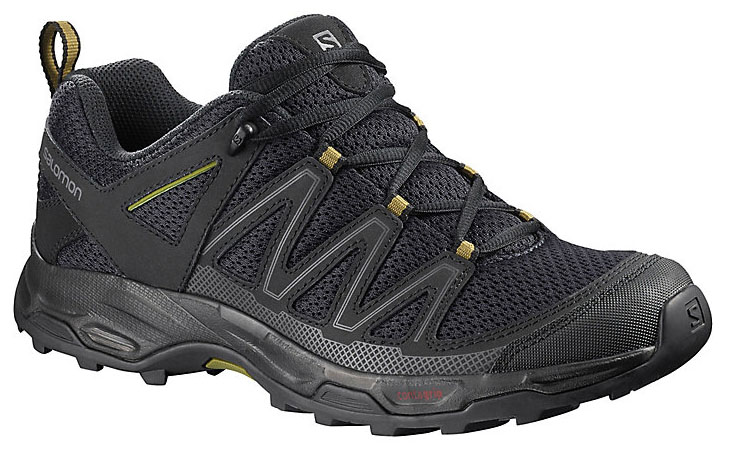 Weight: 1 lb. 7.6 oz.
Weight: 1 lb. 7.6 oz.
Waterproof: No
What we like: A well-rounded entry-level option at a great price.
What we don’t: Decidedly basic build and middling on-trail performance.
At $80, the Pathfinder is Salomon’s most affordable hiking shoe and a great entry-level option for those just getting started. The design is decidedly basic with a standard lacing system (no Quicklaces), no waterproofing, a synthetic upper, and none of Salomon’s premium midsole or outsole upgrades, but it’s perfectly serviceable for day hiking and the occasional short backpacking trip. Weight and styling are competitive too, with the Pathfinder checking in at 1 pound 7.6 ounces per pair and featuring relatively modern styling that looks similar (at first glance) to the premium X Ultra.
From a performance perspective, however, the Pathfinder falls well short of that shoe. In comparing it to the non-waterproof version of the X Ultra, the Pathfinder has a less aggressive outsole with shallower lugs, lacks Salomon’s ADV-C chassis (read: less stability), and uses less hardwearing materials along the upper. The X Ultra does cost a considerable $40 more than the Pathfinder, but the added investment is well worth it for hikers and backpackers who get out regularly. And if you want waterproofing, unfortunately the Pathfinder doesn’t come in a Gore-Tex model. But for the occasional national park trip or those who stick to well-maintained and smooth trails, it’s an undeniable value and a standout among entry-level options from other brands.
See the Men's Salomon Pathfinder See the Women's Salomon Pathfinder
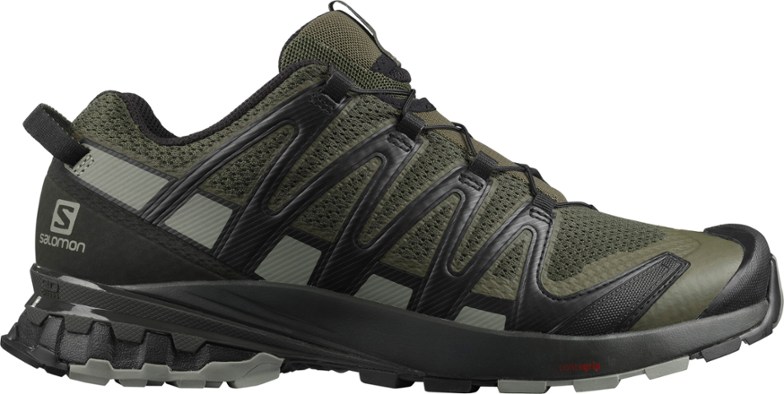 Weight: 1 lb. 8 oz.
Weight: 1 lb. 8 oz.
Waterproof: No (GTX available)
What we like: Comfortable and light while still fully trail-worthy.
What we don’t: Lacks protection at the top of the foot and interior feels a little dated.
Technically designed for trail running, Salomon’s XA Pro 3D v8 arguably is best suited for fast-and-light hiking. The tongue and collar are well padded and comfortable, and the SensiFit system, which extends from the midsole to the mesh upper, creates a snug and secure hold around the foot. Despite its running focus, protection is also surprisingly good thanks to a large and burly toe cap, rigid heel cup, and solid 3D Advanced chassis, and the shoe proved to be more supportive and stable than anticipated as well. Added up, you get the comfort and weight of a running shoe with the traction, durability, and protection of a hiker—a very competitive combination for hikers and backpackers carrying loads of around 35 pounds or less.
However, the XA Pro does have its downsides for hiking. First, it’s not stiff enough for technical terrain or when shuttling a heavier pack—for that, we’d upgrade to the X Ultra or Quest. We also found that it felt a little outdated and unpolished along the interior, which is especially noticeable when worn back-to-back with sleeker, bouncier, and more modern designs like the X Raise. And finally, the XA Pro is pretty thin at the top, which can lead to abrasion and tears through the fairly minimalist mesh upper. This tweener status makes the XA Pro a fairly niche shoe—it’s heavier and stiffer than most trail runners and not as durable or stable as Salomon’s other low-top hikers—but we do like the versatility. Note: Salomon’s XA offerings also include the XA Wild and XA Collider, but we consider those designs better trail runners than hikers... Read in-depth review
See the Men's Salomon XA Pro 3D v8 See the Women's Salomon XA Pro 3D v8
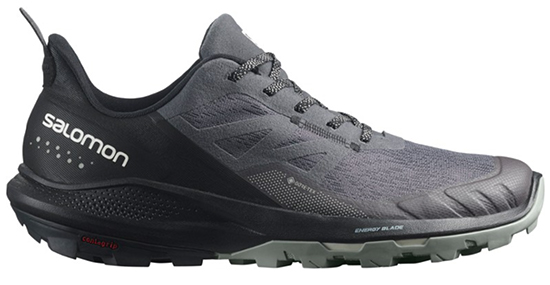 Weight: 1 lb. 8.8 oz.
Weight: 1 lb. 8.8 oz.
Waterproof: Yes (non-GTX available this spring)
What we like: Low weight and energetic, responsive feel.
What we don’t: Not as stable, durable, or protective as other options above.
Like the OUTline Low GTX above but for $10 more, the new OUTpulse GTX takes cues from Salomon’s running shoe collection. Comparable in weight and support to the OUTline, the OUTpulse offers a slightly wider fit and is designed to maximize responsiveness and agility on the trail. The Fuze Surge midsole is comprised of Salomon’s softest foam compound and delivers a very springy but smooth ride (the curved shape helps), while the SensiFit upper (also seen in the XA Pro 3D V8 above) nicely hugs the foot and provides a snug and secure feel. Taken together, the OUTpulse looks and feels a lot like a trail running shoe but with noticeably better support and protection.
However, while we like the OUTpulse for its nimbleness and running shoe-like comfort and agility, it’s decidedly underbuilt for covering longer distances over technical terrain. One issue is that the shoe’s lugs are on the shallow end and spaced closely together, which means they won’t bite well into thick and soft surfaces like mud. In testing the mid-height variation of the OUTpulse, we also had concerns about the knit-like upper succumbing to snags and abrasion over time (it hasn’t yet, but it’s too soon to make a call on long-term durability), and our boot had noticeable gaps where the toe cap connects to the rest of the upper. In the end, the new OUTpulse may work for quick outings with a bit of trail running mixed in, but like the OUTline and other trail runner-inspired models, it's not a standout in durability, protection, or support for more involved objectives.
See the Men’s OUTpulse GTX See the Women’s OUTpulse GTX
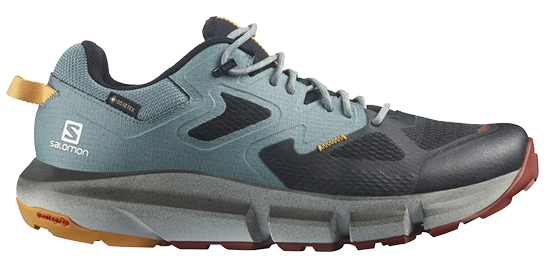 Weight: 1 lb. 8.1 oz.
Weight: 1 lb. 8.1 oz.
Waterproof: Yes
What we like: Maximalist cushioning for long miles.
What we don’t: Narrow fit; flexibility and padding detract from on-trail performance.
The fact that the Predict Hike GTX shares its name with some of Salomon’s road running shoes might tell you something about its intentions. One of the most cushioned hiking shoes that Salomon offers, the Predict provides serious comfort for logging long miles on the trail. The unique grooves underfoot are designed to guide and propel your foot as you move, while the Energy Surge midsole provides a soft and well-padded feel and nicely isolates your foot from harsh impacts below. And unlike the Predict road running shoes, the Predict Hike includes a Gore-Tex liner and Contagrip outsole with reasonably deep lugs for biting into variable surfaces (it’s also sold in a mid-height variation with over-the-ankle coverage for $20 more).
Salomon offers a lot of trail runner-inspired hikers, but the Predict Hike GTX is arguably the closest option to a true running shoe, which makes it great for covering long distances over easy to moderate terrain with minimal weight. However, the tradeoff to that flexible and agile feel is that the shoe isn’t built for navigating rough and rugged ground with a full pack. In testing the mid-height version of the shoe, we experienced discomfort from the narrow toe box on steep terrain and were disappointed by the lack of ankle support and structure. The exposed foam midsole is another area of concern and can be easily damaged on rough ground. In other words, the Predict Hike is a pretty targeted design and far less versatile than options like the X Ultras or X Raise above. But if you’re coming from a running background and don't want to make major concessions in terms of weight or sprightliness, it may be a good fit.
See the Men’s Predict Hike GTX See the Women’s Predict Hike GTX
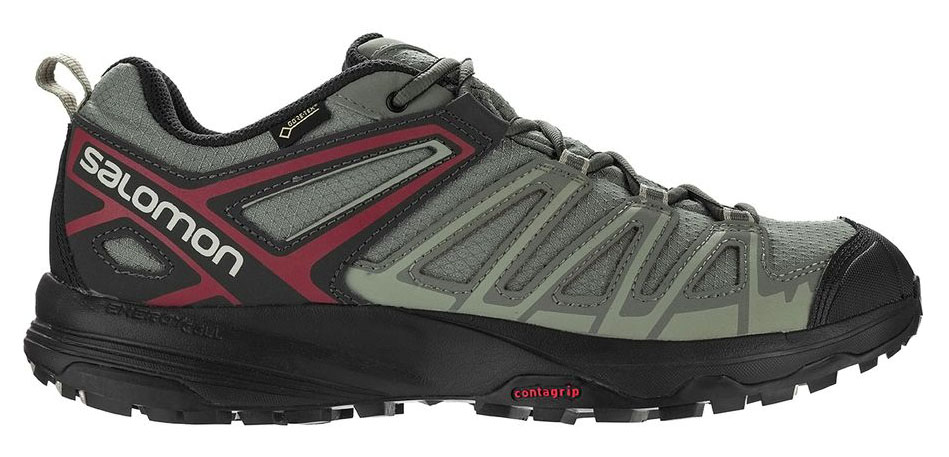 Weight: 1 lb. 8.7 oz.
Weight: 1 lb. 8.7 oz.
Waterproof: Yes (non-GTX available)
What we like: Quality and hardwearing materials for $30 less than the X Ultra.
What we don’t: Less of a high-performance design.
On first glance, the X Crest looks strikingly similar to the X Ultra above. In fact, the fit of the shoe is based on the X Ultra series, with a cushioned but supportive build for maximizing long-distance comfort. Other notable features include a quality Gore-Tex liner, mesh and textile upper for added breathability, and protective toe cap and heel counter for shrugging off direct hits to rocks and roots. Additionally, the PU-coated leather along the upper is designed to withstand rugged trail use, and the SensiFit system (shared with the OUTpulse and XA Pro 3D above) cradles the foot and provides a snug, customized fit all around.
In parsing out the differences between the X Crest and X Ultra, the X Crest has a less aggressive outsole design, uses a less premium insole, and lacks the X Ultra's solid chassis, winged eyelet that connects the lacing system and midsole, and single-pull Quicklace system. The net result is less stability, support, and grip, which limits its appeal for truly rough terrain, but you still get great all-around protection and high-quality materials that should stand up well to moderate use. And the clincher for some will be cost: At $30 less than the X Ultra 4, the X Crest is an excellent value for hikers and backpackers who don’t need the X Ultra’s high levels of performance.
See the Men's Salomon X Crest GTX See the Women's Salomon X Crest GTX
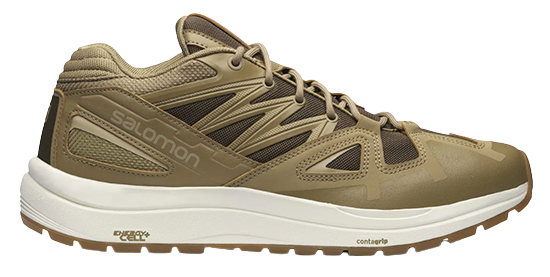 Weight: 1 lb. 6.6 oz.
Weight: 1 lb. 6.6 oz.
Waterproof: No
What we like: Roomier fit than most other Salomon designs.
What we don’t: Expensive for the levels of performance.
Salomon’s Odyssey line was designed with long-distance comfort and durability in mind, and the latest Odyssey 1 Advanced model carries the torch. Like its predecessors, the latest Odyssey boasts a wide forefoot to account for natural toe splaying and plenty of cushioning at the midsole for long days on the trail. The rectangular, closely spaced lugs aren’t particularly aggressive, but the shoe is plenty capable for moving quickly over easy to moderate terrain. A final highlight is the feathery 1-pound-6.6-ounce build, although it’s worth noting that the Odyssey isn’t available with a waterproofing membrane (which would likely add another ounce or two).
We haven’t had a chance to test the latest iteration of the Odyssey just yet, but we do have experience with the since-discontinued Odyssey Triple Crown, which shared similar intentions but with a more technical aesthetic (the new Odyssey looks surprisingly casual). For reference, we found the Triple Crown to be very comfortable and breathable, although it was a noticeable step down in support and stiffness than options like the X Ultra and Quest above (even the similarly light X Raise will offer a boost in stability for navigating tricky terrain). In the end, the Odyssey is a pretty niche design and lacking in performance compared to many other options here, but it has its place for those aiming to cover a lot of easy ground quickly. Of note: The Odyssey is considered a unisex design, so be sure to size accordingly.
See the Salomon Odyssey 1 Advanced
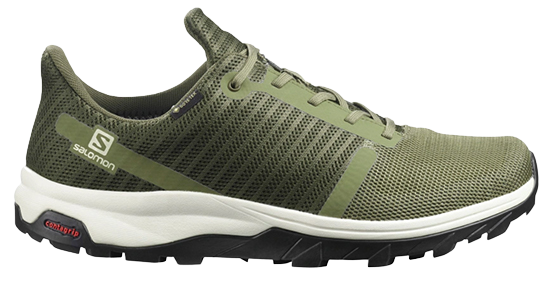 Weight: 1 lb. 4.8 oz.
Weight: 1 lb. 4.8 oz.
Waterproof: Yes (Non-GTX available)
What we like: Comfortable materials, modern looks, and the lightest option here.
What we don’t: Minimal protection and durability (it's more casual than it is technical).
The lightest shoe in Salomon’s hiking lineup is the 1-pound-4.8-ounce Outbound Prism GTX, and it also happens to be the most everyday-friendly too. With a more streamlined and minimalist look and design than most of the models above, the Outbound combines soft, breathable fabrics and a pre-shaped tongue for comfort with Salomon’s All Terrain Contagrip outsole for off-pavement traction and a Gore-Tex membrane for sealing out moisture. All told, it's a really stylish and modern-looking shoe with enough of a technical slant for light day hiking.
In addition to being one of the most casual and around town-friendly options that Salomon offers, the Outbound Prism GTX is also a good value at just $100 for the waterproof version ($80 for the non-waterproof variation). That said, its casual focus does detract from on-trail capabilities: The Outbound offers very limited toe and foot protection (including a cutout around the ankle), and the mesh-heavy upper is thin and will likely wear down quickly if you venture onto technical ground. But the price and looks are hard to beat, making the Outbound an enticing option for casual hikers who want one shoe to wear both on and off the trail.
See the Men’s Outbound Prism GTX See the Women’s Outbound Prism GTX
| Salomon Shoe | Price | Weight | Waterproof | Upper | Outsole | Non-WP available? |
|---|---|---|---|---|---|---|
| X Ultra 4 Mid GTX | $165 | 1 lb. 14 oz. | Yes (Gore-Tex) | Leather / textile | AT Contagrip | No |
| Quest 4 GTX | $230 | 2 lb. 14.2 oz. | Yes (Gore-Tex) | Leather / textile | AT Contagrip | No |
| X Ultra 4 GTX | $150 | 1 lb. 11.5 oz. | Yes (Gore-Tex) | Synthetic | AT Contagrip | Yes |
| X Ultra 3 Mid GTX | $165 | 1 lb. 15.7 oz. | Yes (Gore-Tex) | Leather | Mud Contagrip | Yes |
| X Raise Low GTX | $130 | 1 lb. 7.6 oz. | Yes (Gore-Tex) | Synthetic | AT Contagrip | Yes |
| OUTline Low GTX | $130 | 1 lb. 8.6 oz. | Yes (Gore-Tex) | Synthetic | AT Contagrip | Yes |
| Cross Hike Mid GTX | $170 | 1 lb. 11.9 oz. | Yes (Gore-Tex) | Synthetic | AT Contagrip | No |
| Outward Mid GTX | $150 | 1 lb. 15.7 oz. | Yes (Gore-Tex) | Leather / mesh | AT Contagrip | No |
| Vaya Mid GTX | $160 | 1 lb. 7.3 oz. | Yes (Gore-Tex) | Synthetic | AT Contagrip | Yes |
| Pathfinder | $80 | 1 lb. 7.6 oz. | No | Synthetic | AT Contagrip | N/A |
| Xa Pro 3D v8 | $130 | 1 lb. 8 oz. | No (GTX available) | Synthetic | AT Contagrip | N/A |
| OUTpulse GTX | $140 | 1 lb. 8.8 oz. | Yes (Gore-Tex) | Synthetic | AT Contagrip | Yes |
| Predict Hike GTX | $160 | 1 lb. 8.1 oz. | Yes (Gore-Tex) | Synthetic | AT Contagrip | No |
| X Crest GTX | $120 | 1 lb. 8.7 oz. | Yes (Gore-Tex) | Leather / textile | AT Contagrip | Yes |
| Odyssey 1 Advanced | $190 | 1 lb. 6.6 oz. | No | Synthetic | Mud Contagrip | N/A |
| Outbound Prism GTX | $100 | 1 lb. 4.8 oz. | Yes (Gore-Tex) | Synthetic | AT Contagrip | N/A |
Reasonably low weights have been a longtime staple of Salomon’s hiking lineup, and that holds true with their 2022 collection. The picks above range from the light and agile Outbound Prism (1 lb. 4.8 oz.) to the burly, backpacking-ready Quest GTX boot (2 lbs. 14.2 oz.). Weight correlates closely with each shoe’s intentions: For instance, the synthetic, running shoe-like Outbound Prism is best suited for day hiking on smooth and well-maintained trails, while the more traditional leather Quest is purpose-built for covering rough and rugged terrain under the weight of a fully loaded pack. Designs like the X Ultra 4 Mid GTX (1 lb. 14 oz.) strike a nice middle ground, combining a reasonably light build with quality materials and excellent comfort, traction, and on-trail capabilities.
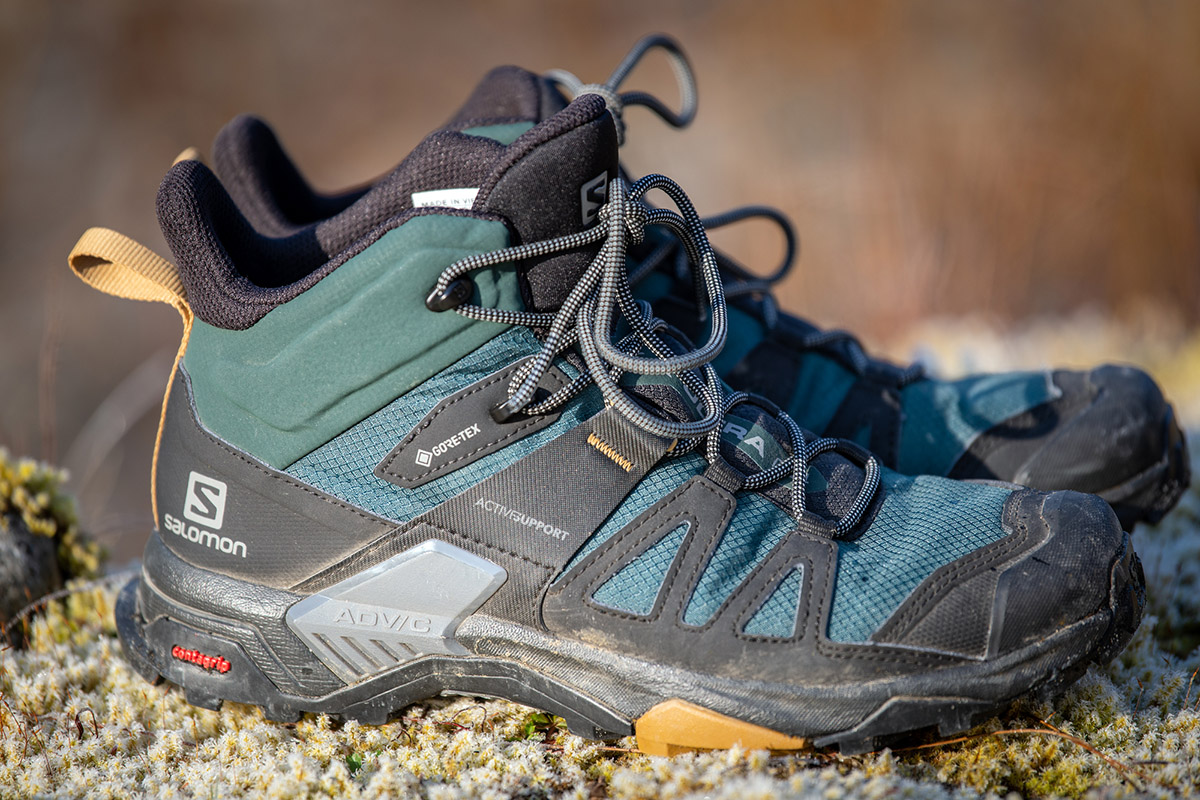
Keep in mind, however, that cutting weight often translates to reduced durability, as evidenced with the OUTline Low GTX (1 lb. 8.6 oz.) and Cross Hike Mid GTX (1 lb. 11.9 oz.), both of which suffered premature delamination issues. Fast-and-light designs like the aforementioned Outbound Prism and Odyssey 1 Advanced (1 lb. 4.8 oz. and 1 lb. 6.6 oz., respectively) also fall short in support and stability, which is perfectly fine for short outings but will suffer over longer distances under heavy loads. In the end, a final decision will come down to your objectives and what type(s) of terrain you expect to encounter. If you’re headed out on a demanding, multi-day backpacking trip with a full pack, it’s simply hard to beat the protection, coverage, and support you get from beefier leather designs like the Quest or Quest Element (2 lbs. 6.4 oz.).
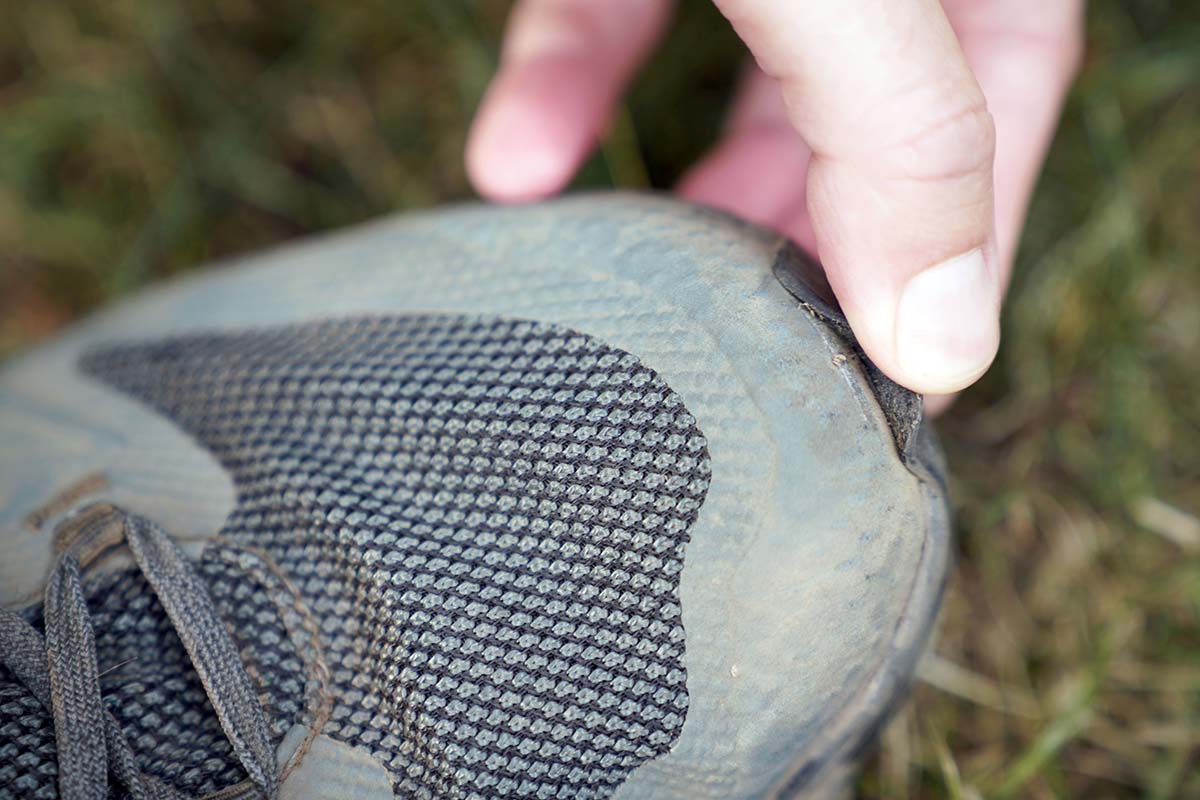
As with weight, cushioning and comfort vary within Salomon’s collection and line up closely with each model’s intended use. At the extreme end are the soft and trail runner-like Predict Hike GTX and X Raise, the latter of which impressed us with its highly padded interior and long-distance comfort. Moving toward the middle of the spectrum, you have well-rounded options for hiking and backpacking, including the X Ultra and Quest, which nicely balance cushion and support for carrying a heavier pack. And on the minimalist end, there’s the relatively thin OUTline, which is best suited for easy trails and led to foot soreness over longer distances. The trail running-focused XA Pro 3D v8 is another shoe lacking in plushness, with a fairly dated and rough-feeling interior that gave it a stiff and cumbersome feel. We always recommend trying on shoes before you buy to ensure a good all-around fit, but it can also help a lot with evaluating the amount of padding underfoot and gauging what feels best to you given your objectives.
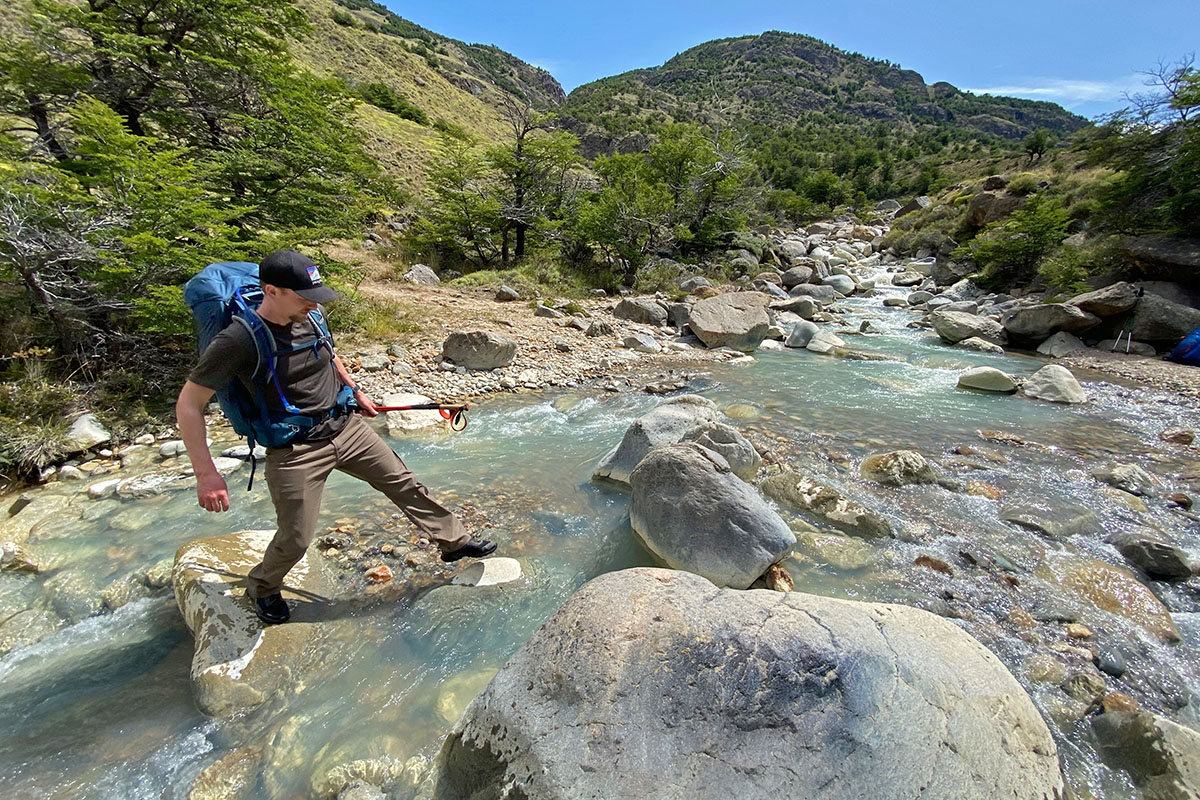
Stability and support are the result of a number of factors, including the height of the shoe or boot, the amount of flex in the design, the snugness of the lacing system, the level of cushioning underfoot, and overall weight, to name a few. For instance, the X Raise has a trail runner-like feel and lightweight build, but we found it to be noticeably lacking in stability—the soft midsole flexed more than we’d like on extended climbs, and it was harder to trust than the X Ultra 4 while hopping across boulders with a pack. In the mid-height category, the lightweight Cross Hike was also disappointing, with a loose collar and laces that slipped slightly over long distances. On the flip side, the burly Quest 4 is a standout when it comes to support, with a tall build, snug and secure lacing system, wide base, stiff heel, and sturdy, planted feel. To help you gauge a shoe’s abilities, Salomon has a helpful graphic on each product page that highlights the level of support, ranging from flexible to stable.
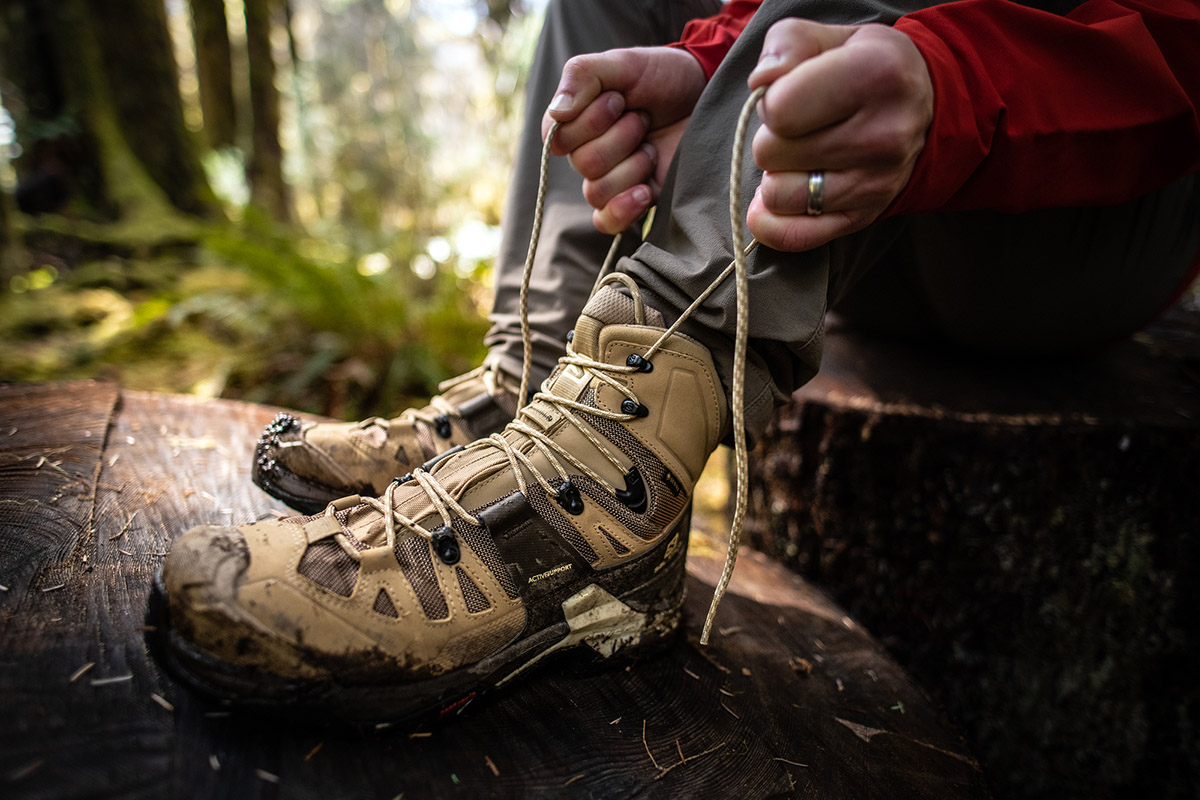
Salomon is known for their in-house Contagrip rubber, but the shoes above still vary widely based on lug depth and spacing and the type of compound used. Their All Terrain compound is used for the majority of their designs and focuses on maximizing traction over a wide variety of surfaces. The other variation, called Mug Contagrip, is built specifically for biting into softer and looser terrain like mud (although the lug design plays a huge role, which we cover below). Models that utilize the Mud compound include the X Ultra 3 and Odyssey 1 Advanced.
As we mentioned, lug design also has a big impact on traction and grip. For instance, Salomon’s X Ultra 4 has deep, chevron-shaped lugs that are easy to trust and do a great job biting into most surfaces while not being overly flexible or prone to premature wear. Wider spacing, like you get with the Cross Hike, is better for deep mud and softer ground, although that shoe suffers some on wet rock. Similar to support above, you can take a look on Salomon’s website to see what type(s) of terrain each shoe is designed to handle (easy paths, mixed, or technical terrain).
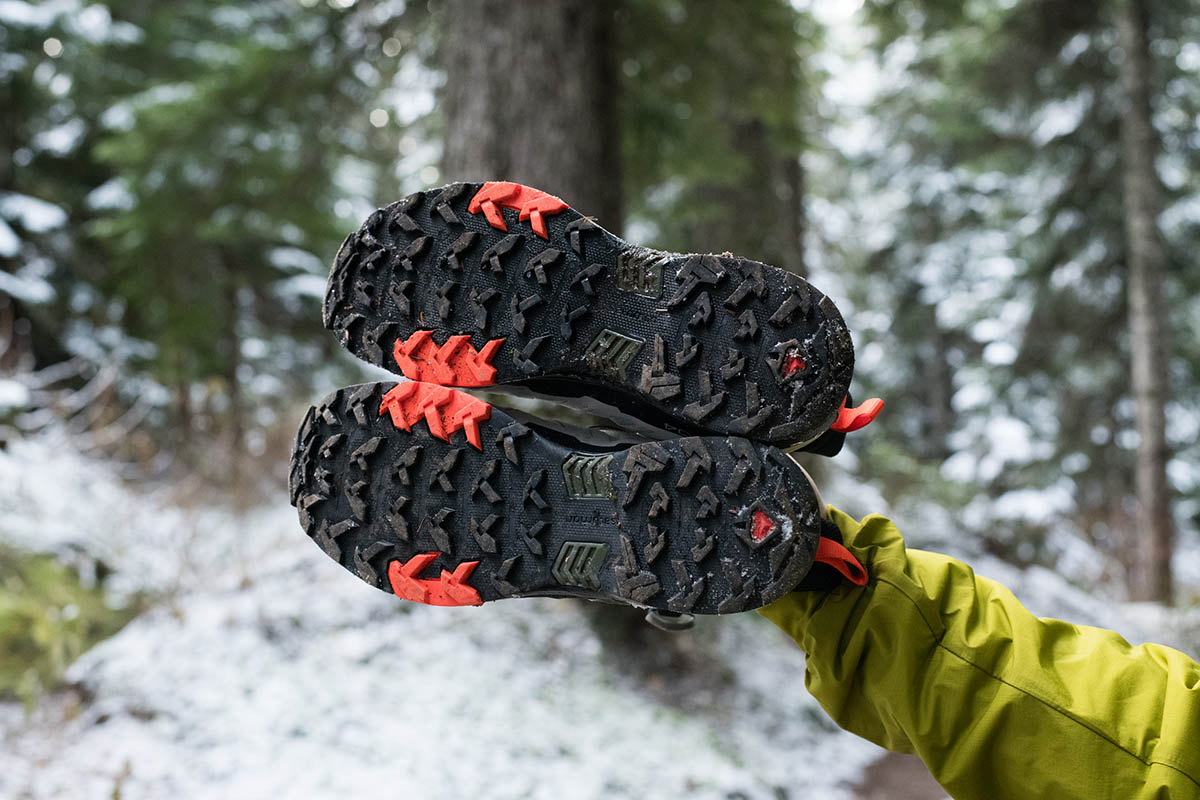
As we mentioned previously, weight is a good indicator of a shoe’s durability, but it’s not the only factor to consider. The type of materials used also play a key role, with burly leather models like the Quest and Quest Element sitting at the top of the heap. The Outward Mid is another quality option, with a mix of nubuck leather and mesh that nicely balances weight and durability. And the X Ultra 4 Mid uses a similar combination of PU-coated leather and synthetic materials that have proven to be plenty hardwearing and robust for everything from day hiking to light backpacking. At the other end of the spectrum are designs like the OUTline and Cross Hike, both of which utilize light synthetic uppers to cut weight and suffered premature delamination issues very early into testing. Again, not everyone will need the assurance of a full leather boot, but it’s important to evaluate your priorities closely before committing to a truly lightweight design.
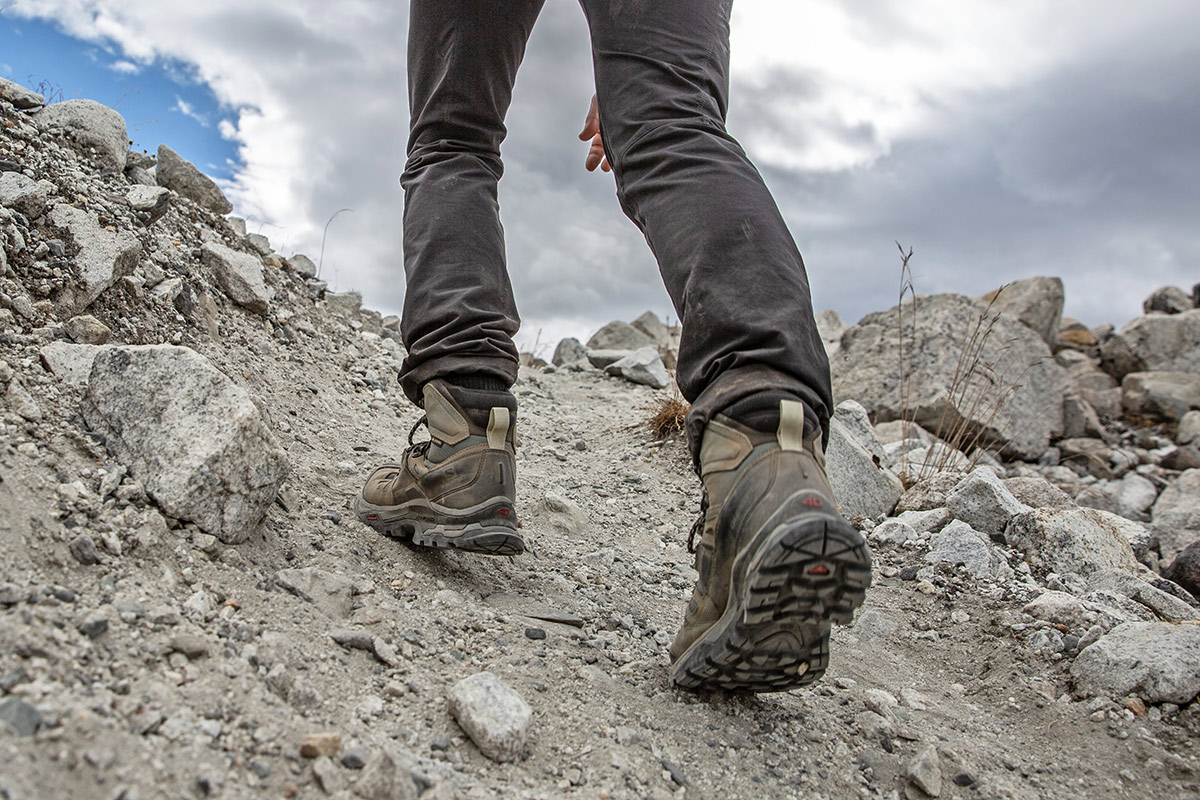
We often prefer Gore-Tex shoes given our roots in the rainy Pacific Northwest, but waterproof designs do tend to suffer when it comes to breathability. To be sure, Gore-Tex is best-in-class in terms of balancing these two conflicting priorities, but our feet do grow sweaty from time to time during the heat of summer. Thankfully, Salomon offers many of their designs in both waterproof and non-waterproof variations, including the ultra-popular X Ultra, X Raise, OUTline, Vaya, XA Pro 3D v8, OUTpulse, X Crest, and Outbound Prism.
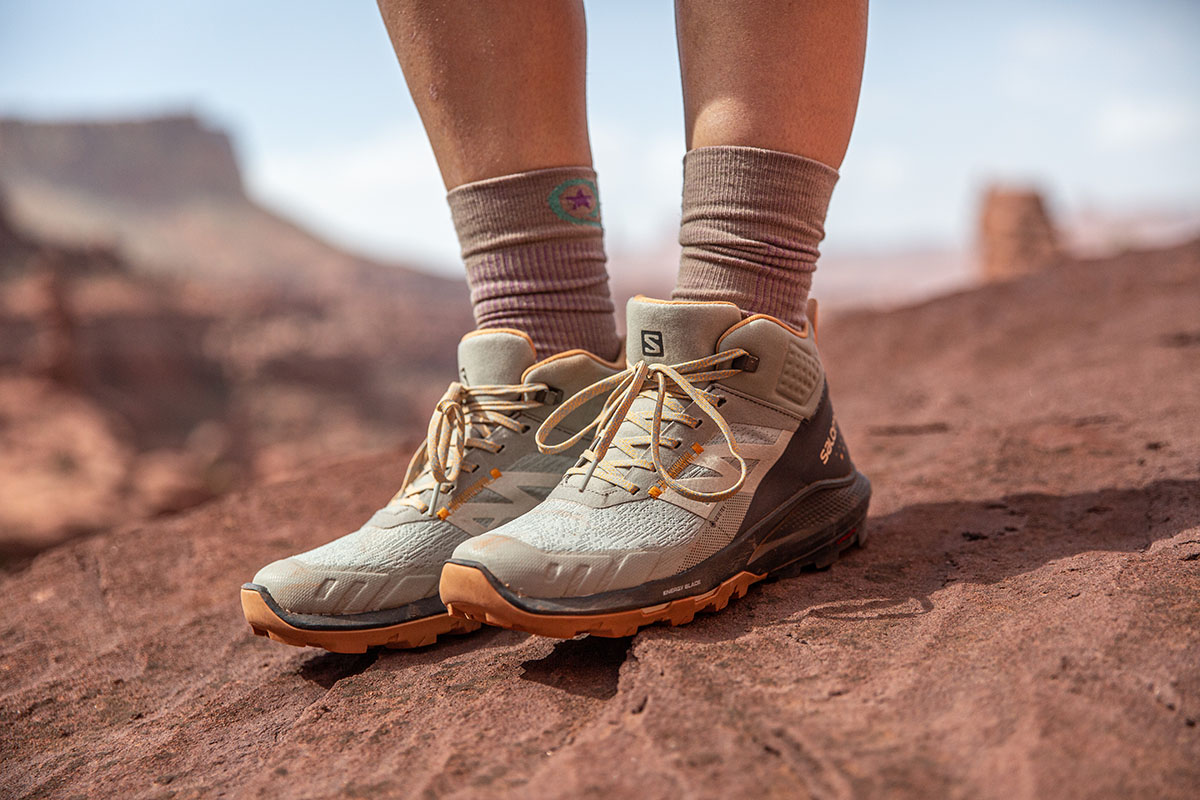
Our take is this: If you live in an ultra-dry climate or plan to ford deep bodies of water, go with a non-waterproof design. These models tend to dry out much quicker should they get submerged and will save you a bit of cash and weight too. For example, the non-waterproof X Ultra 4 costs $120 and checks in at 1 pound 9.4 ounces while the Gore-Tex version is $150 and 1 pound 11.5 ounces. For hiking and backpacking in areas with consistent rain or snow, it might be worth spending up for the Gore-Tex-equipped option. For more background on this topic, see our article: Do You Need Waterproof Hiking Shoes?
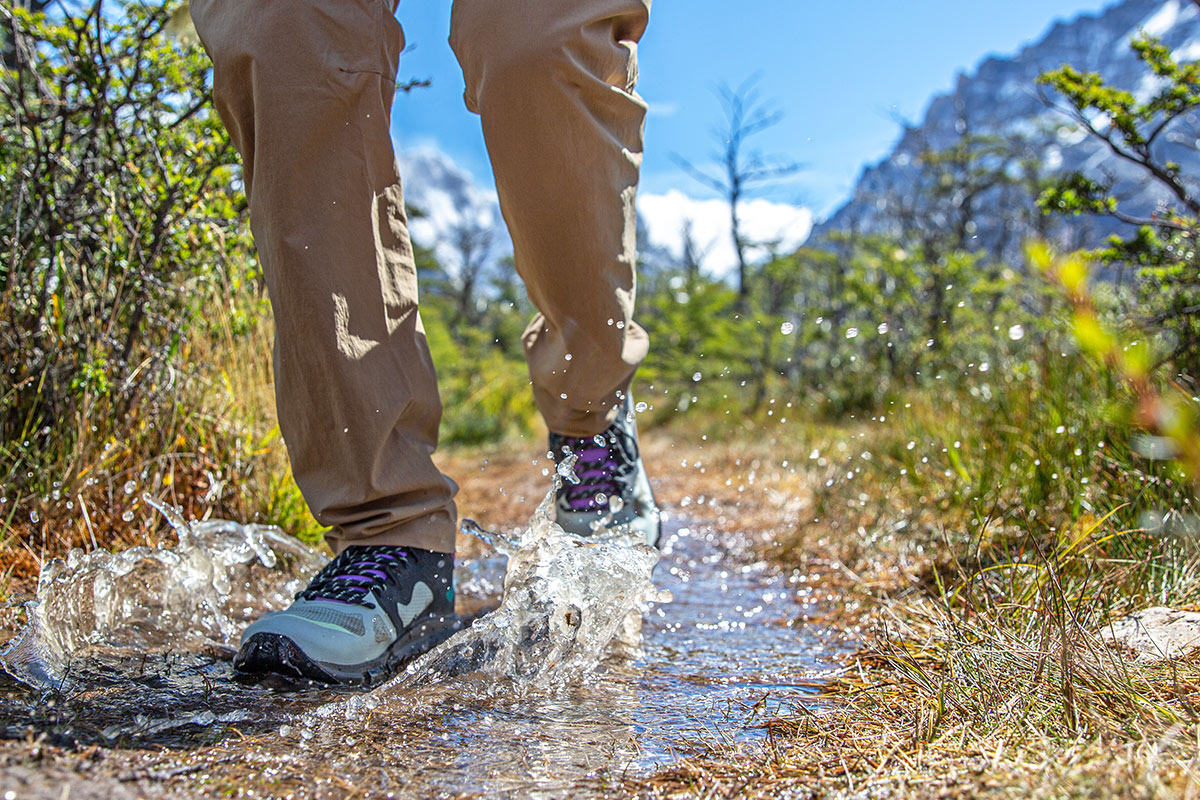
One of Salomon’s signature features is their single-pull Quicklace system, which is featured on a number of the designs above, including the Cross Hike, X Raise, XA Pro 3D v8, and low-top version of the X Ultra 4 (the Mid uses standard laces). The main advantage is convenience: It’s easy to get an even cinch with a single pull, and everything tucks away nicely into a stretchy pocket on the tongue. In practice, we’ve had very few issues with the system loosening on the trail, and many appreciate the quick on/off process and user-friendly nature.
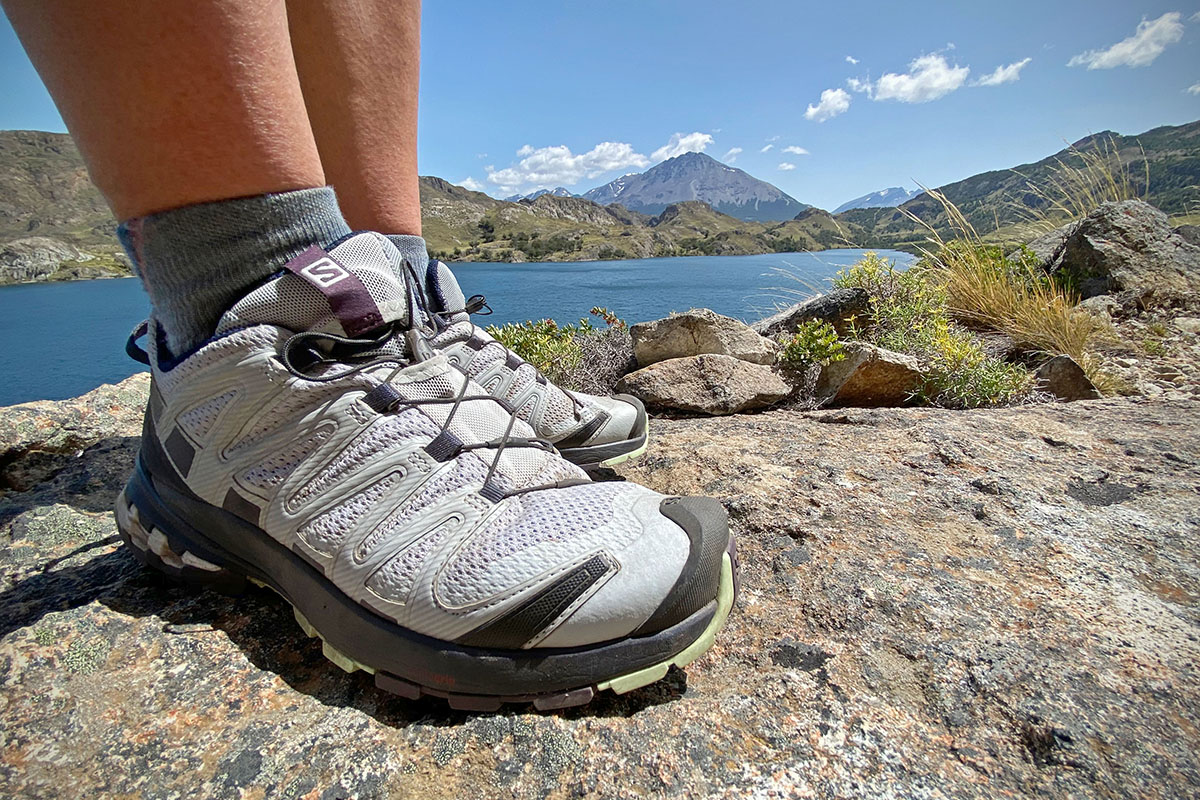
That said, the Quicklace system does have its drawbacks. Most notably, you can’t customize the fit around different parts of the foot like you can with traditional laces, which can be an issue for those with finicky feet or who prefer added looseness or snugness in a certain area. Additionally, the added moving parts mean more potential points of failure over time, although we haven’t experienced any durability issues throughout years of testing. All in all, it’s not a deal breaker for many, and Salomon’s single-pull design is the smoothest and most user-friendly that we’ve tested to date.
Salomon is a leader in the hiking footwear market, with an impressively comprehensive and well-rounded collection of boots and shoes for everything from short day hikes to demanding multi-day backpacking trips. That said, there are a number of formidable competitors in 2022. Two long-time rivals are Merrell and KEEN, both of whom have similarly well-executed lineups that cover the hiking and backpacking realms. Merrell in particular has a number of high-quality options, including the legendary Moab (a popular first hiking shoe or boot for many folks) and fast-and-light MQM Flex. And KEEN’s signature Targhee series has been a best-seller for years for its great out-of-the box comfort, tough construction, and wide range of styles and colorways.
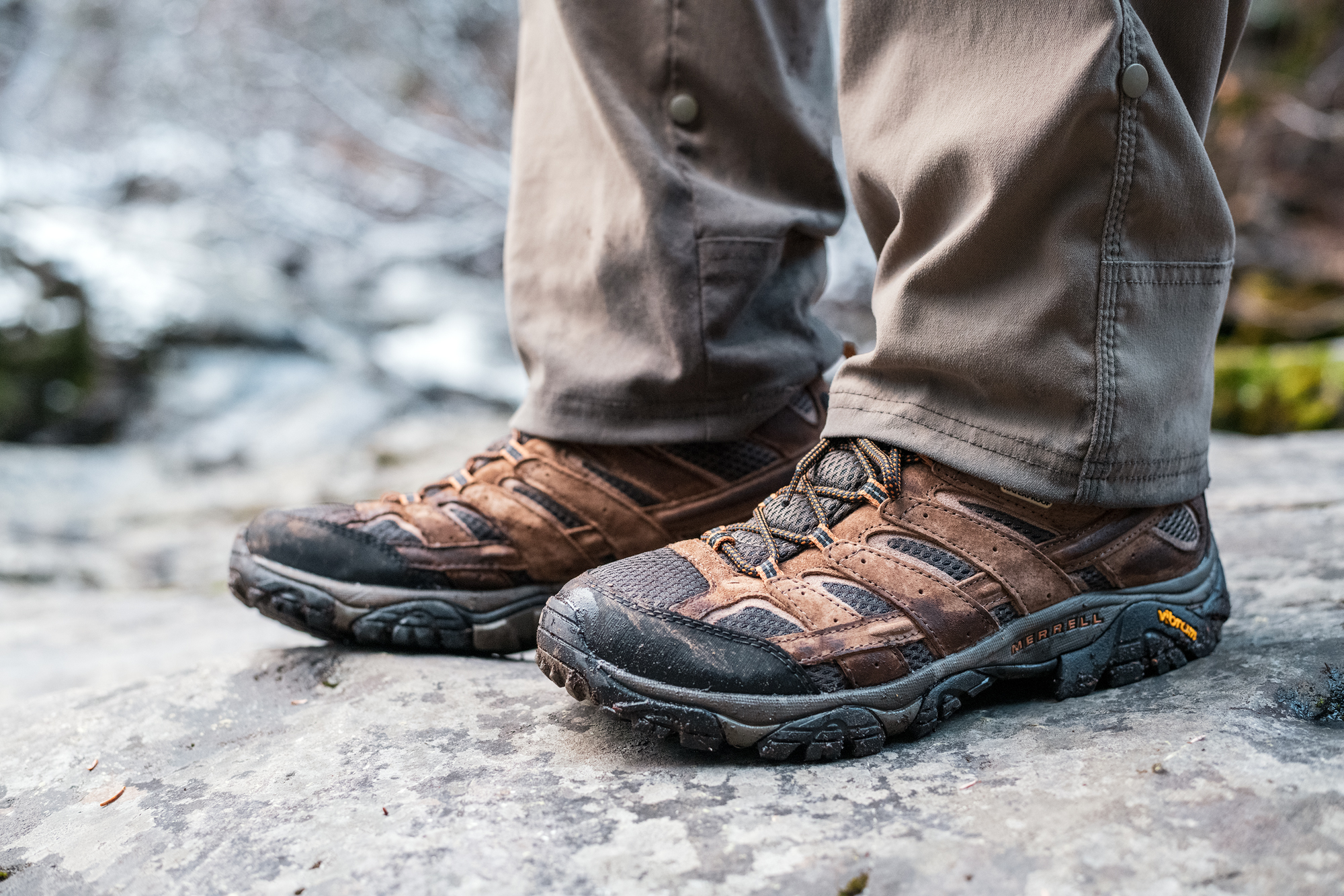
That said, neither brand is as much of an innovator as Salomon, and the sheer number of available styles and designs are limited by comparison. Oboz is another big name in the market, although we’ve found that many of their boots have more of a traditional look and feel than Salomon’s more modern designs. A few final (albeit more specialized) brands to have on your radar are LOWA, La Sportiva, and Vasque, but again, their collections aren’t as well rounded or wide-ranging. For a more detailed breakdown of the market, see our article on the best hiking footwear brands.
Back to Our Salomon Hiking Footwear List Back to Our Hiking Footwear Comparison Table